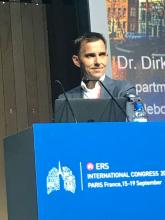PARIS – In a sham-controlled randomized trial that enrolled patients with moderate to severe was not only found safe, which was the primary goal of the study, but effective, according to data presented at the annual congress of the European Respiratory Society.
Within the first year of follow-up, “the positive benefit in those randomized to TLD persisted with a more than 50% reduction in the number of patients hospitalized for respiratory complications,” reported Dirk-Jan Slebos, MD, department of lung diseases and tuberculosis, University of Gröningen, the Netherlands.
In this phase 2 trial, called AIRFLOW-2, 82 patients were randomized to receive TLD, which ablates nerves with radiofrequency energy, or a sham procedure. The study enrolled patients with moderate to severe COPD and forced expiratory volume in 1 second of 30%-60% predicted. All patients were treated with the long-acting muscarinic antagonist (LAMA) tiotropium.
The primary endpoint was a composite of respiratory-related adverse events, such as respiratory failure, worsening bronchitis, or worsening dyspnea. Secondary endpoints included serious adverse events of any kind as well as a variety of measures of efficacy, including changes in quality of life as measured with standardized tools such as the St. George’s Respiratory Questionnaire (SGRQ).
Within 6 months of the procedure, 71% of those randomized to the sham procedure and 32% of those treated with TLD experienced one of the predefined respiratory adverse events (P = .0008). At 1 year, 25% of patients in the sham group versus 12% in the TLD group were hospitalized for an exacerbation (P = .039). In addition to achieving greater improvement in several of the individual symptoms, such as dyspnea, those randomized to TLD also achieved numerical improvements in SGRQ scores (–8.3 vs. –3.8) at 12 months.
Gastrointestinal adverse events were more common in the TLD group (15% vs. 5%). Although the higher rate of GI events, which included nausea, bloating, and abdominal discomfort, did not reach statistical significance, it was attributed to off-target exposure of nerves in the GI system to the radiofrequency energy.
“We are improving our imaging process in order to implement additional measures to avoid these nerves,” said Dr. Slebos, who added that this potential risk can be modified. In this study, all of the GI symptoms resolved.
Dr. Slebos emphasized that the 12-month follow-up permitted the study to “confirm that TLD is safe and technically feasible with no late-onset safety signals.” It has set the stage for AIRFLOW-3, a phase 3 trial that is expected to lead to regulatory approval of the catheter if it shows similar safety and efficacy.
The principle of TLD is to deliver energy to ablate parasympathetic pulmonary nerves. The exact mechanism of benefit has not been proved, but it is believed that inhibiting release of acetylcholine that induces smooth muscle constriction has several beneficial downstream effects, including prevention of hyperinflation and reduced mucus production. AIRFLOW-3, like AIRFLOW-2, will evaluate a proprietary catheter developed for this purpose.
“TLD will not replace pharmaceutical therapy. Rather, it appears to have a synergistic effect,” explained Dr. Slebos, who said the procedure is performed on an outpatient basis. The average procedure time for TLD in AIRFLOW-2 was 42 minutes.
The first human study of TLD, also led by Dr. Slebos, was published in 2015. While several subsequent patient series support efficacy and benefit, Daiana Stolz, MD, Clinic for Respiratory Medicine and Pulmonary Cell Research, University of Basel (Switzerland), called the data from this sham-controlled trial “really exciting and important.” However, she said, the larger AIRFLOW-3 trial is needed “to confirm this is an effective and safe treatment.”
Dr. Slebos receives consultancy fees from Aeris Therapeutics, Boston Scientific, Broncus Technologies, CSA Medical. Olympus, Portaero, PulmonX, PneumRx/BTG, and Nuvaira, which provided the funding for this study.


